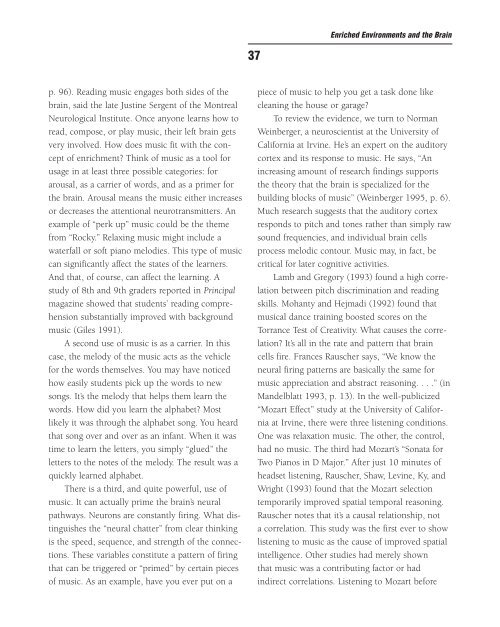Create successful ePaper yourself
Turn your PDF publications into a flip-book with our unique Google optimized e-Paper software.
p. 96). Read<strong>in</strong>g music engages both sides of <strong>the</strong><br />
bra<strong>in</strong>, said <strong>the</strong> late Just<strong>in</strong>e Sergent of <strong>the</strong> Montreal<br />
Neurological Institute. Once anyone learns how to<br />
read, compose, or play music, <strong>the</strong>ir left bra<strong>in</strong> gets<br />
very <strong>in</strong>volved. How does music fit with <strong>the</strong> concept<br />
of enrichment? Th<strong>in</strong>k of music as a tool for<br />
usage <strong>in</strong> at least three possible categories: for<br />
arousal, as a carrier of words, and as a primer for<br />
<strong>the</strong> bra<strong>in</strong>. Arousal means <strong>the</strong> music ei<strong>the</strong>r <strong>in</strong>creases<br />
or decreases <strong>the</strong> attentional neurotransmitters. An<br />
example of “perk up” music could be <strong>the</strong> <strong>the</strong>me<br />
from “Rocky.” Relax<strong>in</strong>g music might <strong>in</strong>clude a<br />
waterfall or soft piano melodies. This type of music<br />
can significantly affect <strong>the</strong> states of <strong>the</strong> learners.<br />
And that, of course, can affect <strong>the</strong> learn<strong>in</strong>g. A<br />
study of 8th and 9th graders reported <strong>in</strong> Pr<strong>in</strong>cipal<br />
magaz<strong>in</strong>e showed that students’ read<strong>in</strong>g comprehension<br />
substantially improved with background<br />
music (Giles 1991).<br />
A second use of music is as a carrier. In this<br />
case, <strong>the</strong> melody of <strong>the</strong> music acts as <strong>the</strong> vehicle<br />
for <strong>the</strong> words <strong>the</strong>mselves. You may have noticed<br />
how easily students pick up <strong>the</strong> words to new<br />
songs. It’s <strong>the</strong> melody that helps <strong>the</strong>m learn <strong>the</strong><br />
words. How did you learn <strong>the</strong> alphabet? Most<br />
likely it was through <strong>the</strong> alphabet song. You heard<br />
that song over and over as an <strong>in</strong>fant. When it was<br />
time to learn <strong>the</strong> letters, you simply “glued” <strong>the</strong><br />
letters to <strong>the</strong> notes of <strong>the</strong> melody. The result was a<br />
quickly learned alphabet.<br />
There is a third, and quite powerful, use of<br />
music. It can actually prime <strong>the</strong> bra<strong>in</strong>’s neural<br />
pathways. Neurons are constantly fir<strong>in</strong>g. What dist<strong>in</strong>guishes<br />
<strong>the</strong> “neural chatter” from clear th<strong>in</strong>k<strong>in</strong>g<br />
is <strong>the</strong> speed, sequence, and strength of <strong>the</strong> connections.<br />
These variables constitute a pattern of fir<strong>in</strong>g<br />
that can be triggered or “primed” by certa<strong>in</strong> pieces<br />
of music. As an example, have you ever put on a<br />
37<br />
Enriched Environments and <strong>the</strong> <strong>Bra<strong>in</strong></strong><br />
piece of music to help you get a task done like<br />
clean<strong>in</strong>g <strong>the</strong> house or garage?<br />
To review <strong>the</strong> evidence, we turn to Norman<br />
We<strong>in</strong>berger, a neuroscientist at <strong>the</strong> University of<br />
California at Irv<strong>in</strong>e. He’s an expert on <strong>the</strong> auditory<br />
cortex and its response to music. He says, “An<br />
<strong>in</strong>creas<strong>in</strong>g amount of research f<strong>in</strong>d<strong>in</strong>gs supports<br />
<strong>the</strong> <strong>the</strong>ory that <strong>the</strong> bra<strong>in</strong> is specialized for <strong>the</strong><br />
build<strong>in</strong>g blocks of music” (We<strong>in</strong>berger 1995, p. 6).<br />
Much research suggests that <strong>the</strong> auditory cortex<br />
responds to pitch and tones ra<strong>the</strong>r than simply raw<br />
sound frequencies, and <strong>in</strong>dividual bra<strong>in</strong> cells<br />
process melodic contour. Music may, <strong>in</strong> fact, be<br />
critical for later cognitive activities.<br />
Lamb and Gregory (1993) found a high correlation<br />
between pitch discrim<strong>in</strong>ation and read<strong>in</strong>g<br />
skills. Mohanty and Hejmadi (1992) found that<br />
musical dance tra<strong>in</strong><strong>in</strong>g boosted scores on <strong>the</strong><br />
Torrance Test of Creativity. What causes <strong>the</strong> correlation?<br />
It’s all <strong>in</strong> <strong>the</strong> rate and pattern that bra<strong>in</strong><br />
cells fire. Frances Rauscher says, “We know <strong>the</strong><br />
neural fir<strong>in</strong>g patterns are basically <strong>the</strong> same for<br />
music appreciation and abstract reason<strong>in</strong>g. . . .” (<strong>in</strong><br />
Mandelblatt 1993, p. 13). In <strong>the</strong> well-publicized<br />
“Mozart Effect” study at <strong>the</strong> University of California<br />
at Irv<strong>in</strong>e, <strong>the</strong>re were three listen<strong>in</strong>g conditions.<br />
One was relaxation music. The o<strong>the</strong>r, <strong>the</strong> control,<br />
had no music. The third had Mozart’s “Sonata for<br />
Two Pianos <strong>in</strong> D Major.” After just 10 m<strong>in</strong>utes of<br />
headset listen<strong>in</strong>g, Rauscher, Shaw, Lev<strong>in</strong>e, Ky, and<br />
Wright (1993) found that <strong>the</strong> Mozart selection<br />
temporarily improved spatial temporal reason<strong>in</strong>g.<br />
Rauscher notes that it’s a causal relationship, not<br />
a correlation. This study was <strong>the</strong> first ever to show<br />
listen<strong>in</strong>g to music as <strong>the</strong> cause of improved spatial<br />
<strong>in</strong>telligence. O<strong>the</strong>r studies had merely shown<br />
that music was a contribut<strong>in</strong>g factor or had<br />
<strong>in</strong>direct correlations. Listen<strong>in</strong>g to Mozart before



